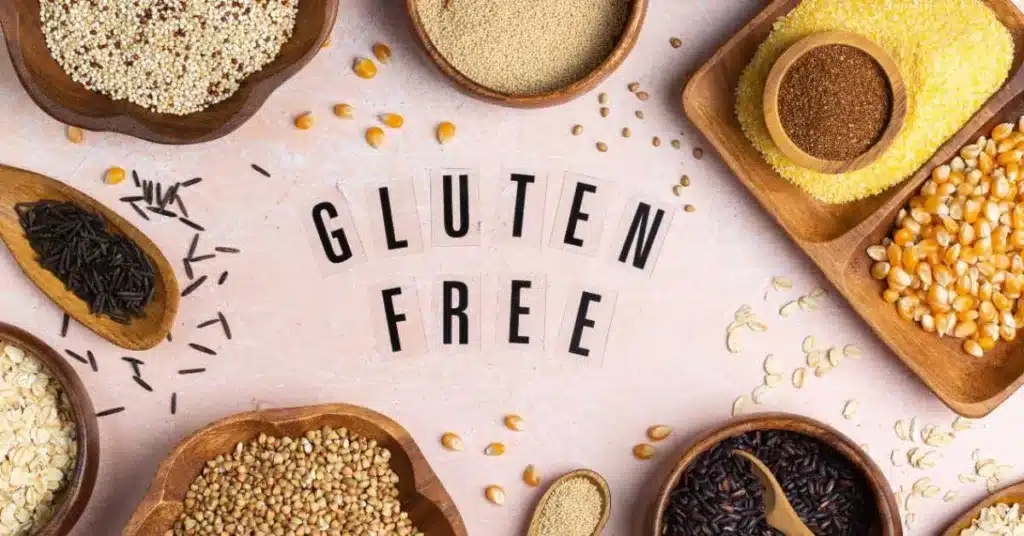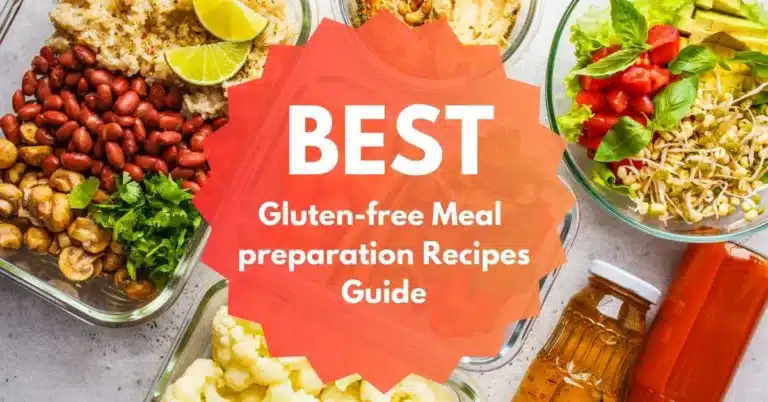Table of contents
Introduction to Gluten-Free Meal Preparation Recipes
Adopting a gluten-free diet is essential for individuals with celiac disease, non-celiac gluten sensitivity, or other health conditions that require the avoidance of gluten—a protein found in wheat, barley, and rye.
Transitioning to a gluten-free lifestyle involves understanding which foods are naturally gluten-free, such as fruits, vegetables, meats, and most dairy products, and being vigilant about avoiding hidden sources of gluten often found in processed foods, sauces, and condiments.
It’s also important to be aware of cross-contamination risks in kitchens where gluten-containing foods are prepared. For more detailed guidance on what constitutes gluten and how it can affect health, visit the Celiac Disease Foundation.
Essential Ingredients for Gluten-free Meal Preparation Recipes
Building a gluten-free pantry is foundational for maintaining a strict gluten-free diet, especially for individuals with celiac disease or gluten intolerance. Here’s a guide to essential ingredients that should feature in your kitchen to keep meals safe and satisfying:
- Whole Grains: Not all grains contain gluten, and some naturally gluten-free options include quinoa, rice (brown, white, wild), buckwheat, sorghum, amaranth, teff, and millet. These grains are versatile and can be used to prepare everything from breakfast porridge to dinner sides.
- Flours and Starches: For baking and thickening, various gluten-free flours are necessary. Almond flour, coconut flour, rice flour, and chickpea flour are popular for their diverse textures and flavors. Starches like cornstarch, tapioca flour, and potato starch are also crucial for giving gluten-free baked goods the right consistency.
- Pasta and Noodles: Gluten-free pasta made from rice, quinoa, or corn helps keep favorite dishes like spaghetti or macaroni on the menu. Asian-style noodles such as rice noodles or buckwheat soba are inherently gluten-free and excellent for diverse recipes.
- Breads and Cereals: Look for gluten-free labeled breads, cereals, and oats (ensure they are certified gluten-free to avoid cross-contamination). These are essential for quick breakfasts or sandwiches.
- Condiments and Sauces: Many sauces and condiments can contain hidden gluten. Opt for those labeled gluten-free. Soy sauce can be replaced with tamari, and various salad dressings, marinades, and stocks are available in gluten-free versions.
Cross-Contamination and Kitchen Safety
For individuals with celiac disease or gluten sensitivity, even trace amounts of gluten can trigger significant health issues. Therefore, maintaining a gluten-free kitchen is critical to avoid cross-contamination. Here are some essential tips to ensure kitchen safety:
- Separate Utensils and Cookware: Use dedicated utensils, cutting boards, and pots for gluten-free cooking. Porous materials like wood can harbor gluten particles, so opt for non-porous materials like stainless steel or silicone that are easier to clean thoroughly.
- Labeling: Clearly label gluten-free items, including containers and storage bins. This helps everyone in the household recognize which items are safe and reduces the risk of accidental gluten exposure.
- Cleaning Protocols: After preparing gluten-containing foods, clean all surfaces thoroughly before using them to prepare gluten-free meals. This includes countertops, stove tops, and dining tables. Use separate sponges and cleaning cloths to avoid transferring gluten residues.
- Toaster Caution: Toasters are a common source of cross-contamination. Consider purchasing a gluten-free toaster, or use toaster bags to protect gluten-free bread.
- Storage Solutions: Store gluten-free products above gluten-containing items to prevent crumbs or particles from falling onto gluten-free foods. This is especially important in pantries and refrigerators.
- Educate Household Members: Make sure all family members or roommates understand the importance of maintaining a gluten-safe kitchen and the practices to prevent cross-contamination.
Gluten-free Meal Preparation Recipes

Breakfast Recipes
Starting the day with a nutritious, gluten-free breakfast is crucial for maintaining energy levels and overall health, especially for those managing celiac disease or gluten sensitivity. Here are some delicious and varied gluten-free breakfast ideas that cater to different tastes and dietary needs:
- Gluten-Free Pancakes: Made with a blend of gluten-free flours such as almond, rice, or coconut flour, these pancakes can be light and fluffy. Enhance them with blueberries or bananas for natural sweetness and added nutrients.
- Oatmeal: Using certified gluten-free oats, prepare a warm bowl of oatmeal. Mix in your favorite toppings like cinnamon, apples, or a drizzle of honey. Oatmeal is excellent for its high fiber content, which aids digestion.
- Smoothie Bowls: Blend a variety of fruits such as berries, bananas, and mangoes with a base of almond milk or yogurt. Top with gluten-free granola, nuts, and seeds for a crunchy texture.
- Egg Muffins: Whisk together eggs, diced vegetables, and your choice of meat like ham or turkey. Pour into muffin tins and bake. These egg muffins are portable, customizable, and perfect for meal prep.
- Chia Pudding: Combine chia seeds with coconut milk or another dairy-free alternative and let it sit overnight. In the morning, top with fresh fruits and a spoonful of nut butter for a meal rich in omega-3 fatty acids and protein.
- Gluten-Free Toast with Avocado: Use a gluten-free bread to make toast topped with mashed avocado, a sprinkle of salt, and crushed red pepper flakes. Add a poached egg or sliced tomatoes for extra flavor and nutrition.
These breakfast options are not only gluten-free but also provide a balanced mix of carbohydrates, protein, and healthy fats to support a healthy diet and lifestyle. They are simple to make and can be varied in many ways to suit your palate and dietary needs.
Lunch and Dinner Recipes
- Quinoa Salad with Roasted Vegetables: Quinoa is a versatile, gluten-free grain that serves as an excellent base for salads. Roast a mix of colorful vegetables like bell peppers, zucchini, and cherry tomatoes, then toss them with cooked quinoa. Add a dressing of olive oil, lemon juice, salt, and pepper. This salad is rich in protein and fiber, making it a fulfilling meal that can be enjoyed warm or cold.
- Stuffed Bell Peppers: Bell peppers stuffed with a mixture of ground turkey, rice, onions, garlic, and diced tomatoes offer a flavorful and satisfying meal. Top with shredded cheese and bake until the peppers are tender and the cheese is bubbly.
- Gluten-Free Pasta Primavera: Use gluten-free pasta as a base and toss it with a variety of sautéed spring vegetables such as asparagus, peas, and carrots. Add a light sauce made from garlic, olive oil, and a splash of gluten-free vegetable broth. Finish with a sprinkle of Parmesan cheese for a dish that’s both colorful and comforting.
- Chicken and Vegetable Stir-Fry: A quick chicken stir-fry with broccoli, bell peppers, and carrots is perfect for a busy weeknight dinner. Use a gluten-free soy sauce or tamari for the stir-fry sauce, mixed with honey and ginger for extra flavor. Serve it over cooked rice or gluten-free noodles for a complete meal.
If want to host a dinner for your beloved, do not hesitate to check out full guide about how to cook gluten-free for guests.
Snacks and Desserts
For those adhering to a gluten-free diet, finding snacks and desserts that satisfy cravings without compromising dietary restrictions is crucial. Here are some delightful gluten-free snack and dessert ideas that are both easy to prepare and delicious.
Snacks
- Gluten-Free Hummus and Vegetables: Hummus is naturally gluten-free and pairs perfectly with a variety of vegetables such as carrots, celery, and bell peppers for a healthy, crunchy snack.
- Cheese and Rice Crackers: A simple yet satisfying snack, gluten-free rice crackers with cheese offer a good mix of carbs and protein, ideal for a quick energy boost.
- Popcorn: Popcorn is a great gluten-free snack as long as it’s not flavored with additives that contain gluten. Season it with a bit of salt and olive oil, or for a sweet treat, a sprinkle of cinnamon and sugar.
- Nut Mix: Make a homemade trail mix with a variety of nuts, such as almonds, walnuts, and pecans, along with some dried fruits like cranberries or apricots for a portable and filling snack.
Desserts
- Flourless Chocolate Cake: Using eggs, sugar, and high-quality chocolate, you can create a rich, decadent cake that’s completely gluten-free and a crowd-pleaser at any gathering.
- Gluten-Free Brownies: There are many recipes available that use gluten-free flour blends to make moist, chewy brownies that taste just as good as traditional ones.
- Rice Pudding: Made with rice, milk (or a dairy-free alternative), sugar, and vanilla, rice pudding is a comforting, simple dessert that can be spiced with cinnamon or nutmeg.
- Fruit Sorbet: A refreshing and light option, fruit sorbet is easy to make with just fresh fruit, water, and a little sugar. It’s naturally gluten-free and can be made with almost any type of fruit.
FAQs on Gluten-Free Meal Preparation Recipes
What does gluten-free mean?
Gluten-free refers to foods that do not contain gluten, a protein found in wheat, barley, and rye. This is essential for individuals with celiac disease or gluten sensitivities, as gluten can trigger harmful reactions.
Can eating gluten-free help with weight loss?
While some individuals might lose weight from eliminating processed foods that contain gluten, gluten-free diets are primarily recommended for health reasons rather than weight loss. It’s important to focus on a balanced diet.
Are all oats gluten-free?
Not all oats are gluten-free due to cross-contamination with gluten-containing grains during processing. Always look for oats specifically labeled as gluten-free.
Is it safe to eat out on a gluten-free diet?
Yes, but it requires caution. Always inform the restaurant of your dietary restrictions and confirm that they can accommodate gluten-free meals to avoid cross-contamination.
What are some hidden sources of gluten?
Gluten can be hidden in many processed foods, sauces, soups, and even some medications or supplements. Always read labels carefully to ensure products are certified gluten-free.
How can I replace gluten in recipes?
Many alternatives like gluten-free flours (rice, almond, coconut), starches (cornstarch, tapioca), and grains (quinoa, buckwheat) can replace gluten-containing ingredients in recipes.

